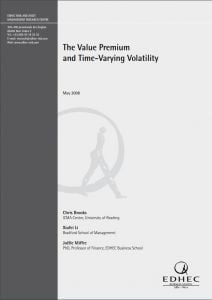

The Value Premium and Time-Varying Volatility
Numerous studies have documented the failure of the static and conditional capital asset pricing models to explain the differences in returns between value and growth stocks. This paper examines the post-1963 value premium by employing a model that captures the time-varying total risk of the value-minus-growth portfolios. The results show that the conditional variance model incorporating time-varying idiosyncratic risk can fully capture the post-1963 value premium. The conclusion is robust to the criterion used to sort stocks into value and growth portfolios, to the inclusion of the size premium into the conditional asset pricing model, and to the country under review (US and UK). This paper therefore adds to the debate on the possible role of idiosyncratic risk in explaining equity returns. A revisited version of this paper was published in the November/December 2009 issue of the Journal of Business Finance and Accounting.
Author(s):
Summary:
Numerous studies have documented the failure of the static and conditional capital asset pricing models to explain the differences in returns between value and growth stocks. This paper examines the post-1963 value premium by employing a model that captures the time-varying total risk of the value-minus-growth portfolios. The results show that the conditional variance model incorporating time-varying idiosyncratic risk can fully capture the post-1963 value premium. The conclusion is robust to the criterion used to sort stocks into value and growth portfolios, to the inclusion of the size premium into the conditional asset pricing model, and to the country under review (US and UK). This paper therefore adds to the debate on the possible role of idiosyncratic risk in explaining equity returns. A revisited version of this paper was published in the November/December 2009 issue of the Journal of Business Finance and Accounting.
Register to download PDF
Register/Log in| Type : | Working paper |
|---|---|
| Date : | 05/05/2008 |
| Keywords : |
Performance Measurement |

